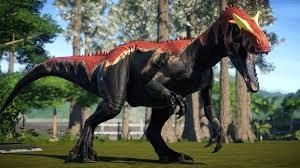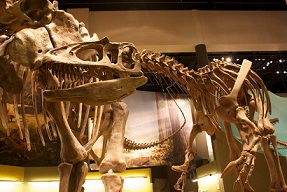
Saurophaganax, whose name means lizard-eating master, is a genus of large theropod Dinosaur that lived during the Late Jurassic period, around 150 million years ago. This formidable predator was among the apex predators of its time and is closely related to the more famous Allosaurus.
Saurophaganax is classified as a theropod dinosaur and is part of the Allosauridae family. The name Saurophaganax was given because of its presumed carnivorous diet. It is considered one of the largest theropod dinosaurs, rivaling Allosaurus and Tyrannosaurus rex in size.
| Name: | Saurophaganax dinosaurs |
| Size: | Around 40-45 feet (12-14 meters) in length. |
| Main Facts: | Saurophaganax was one of the largest theropod dinosaurs, a top predator during the Late Jurassic period, showcasing impressive carnivorous adaptations. |
The first fossils of Saurophaganax were discovered in the Morrison Formation of Oklahoma, USA. These discoveries include partial skeletal remains, primarily consisting of vertebrae, limb bones, and teeth.

Saurophaganax possessed several distinctive physical characteristics :
Saurophaganax was one of the largest theropods, estimated to reach lengths of up to 40-45 feet (12-14 meters) and weigh several tons.
Like all theropods, Saurophaganax walked on two powerful hind limbs.
It had large, serrated teeth designed for tearing flesh, indicating a carnivorous diet.
Its hands were equipped with sharp claws, which would have been used to grasp and hold onto prey.
As an apex predator, Saurophaganax occupied the top of the Late Jurassic food chain, preying on a variety of herbivorous dinosaurs.
Saurophaganax lived during the Late Jurassic, a time when dinosaurs were diverse and thriving. Its fossils have been found in North America, particularly in the Morrison Formation, which was a semi-arid region dominated by vast floodplains and forests.
Being a large theropod, Saurophaganax was likely a formidable predator that actively hunted herbivorous dinosaurs of its time. It used its size, speed, and sharp teeth to capture and consume prey. Its claws would have been valuable for gripping and controlling its victims.
Saurophaganax holds significance in the field of paleontology for several reasons :
It represents one of the largest theropod dinosaurs, contributing to our understanding of dinosaur gigantism and the apex predators of the Late Jurassic.
Saurophaganax's anatomy, including its teeth and claws, offers insights into the adaptations of large theropods for predation.
Its presence in the Morrison Formation provides valuable information about the diversity of Late Jurassic dinosaurs and the ecological interactions between predators and prey.
Saurophaganax is closely related to Allosaurus, and its study helps researchers understand the evolutionary history of these apex predators.
Saurophaganax, a Late Jurassic theropod, was an apex predator known for its colossal size, with a length of up to 40-45 feet. It had sharp, serrated teeth and clawed hands, ideal for capturing and consuming prey. As a carnivore, it hunted herbivorous dinosaurs in its ecosystem. Saurophaganax was closely related to Allosaurus and shared similar characteristics, showcasing adaptations for predation.
Its fossils, primarily found in the Morrison Formation of North America, contribute to our understanding of Late Jurassic ecosystems and the role of apex predators. Saurophaganax stands as an impressive example of theropod gigantism during the age of dinosaurs.
Saurophaganax was a large theropod dinosaur, sharing this classification with famous predators like Tyrannosaurus rex and Allosaurus. Comparing its anatomy and adaptations reveals its position within the theropod lineage.
Saurophaganax was one of the largest theropods, estimated to reach lengths of up to 40 feet (12 meters). Comparing its size to other theropods emphasizes its status as a top predator during its time.
Saurophaganax had sharp, serrated teeth suitable for tearing flesh. Comparing its dental structure to those of other theropods helps us understand variations in hunting strategies and prey preferences.
Fossils of Saurophaganax have been discovered in North America. Comparing its distribution to that of other large theropods like Allosaurus highlights variations in the dinosaur fauna on this continent.
Saurophaganax's classification within the theropod family Allosauridae allows us to trace its evolutionary relationships with other large predators and understand the broader evolutionary history of this group.
While direct evidence of behavior is limited, comparing Saurophaganax's anatomy and potential hunting strategies to those of other theropods offers insights into its predatory behaviors.
Saurophaganax lived during the Late Jurassic period and experienced environmental changes. Comparing its extinction event to those of other dinosaurs aids in our understanding of the factors influencing dinosaur survival and decline.
Comparing Saurophaganax's prey choices and hunting tactics to those of other large theropods helps elucidate its role as a predator in Late Jurassic ecosystems.